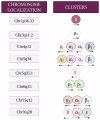GABAergic Influences on Medulloblastoma
- PMID: 40722337
- PMCID: PMC12293591
- DOI: 10.3390/brainsci15070746
GABAergic Influences on Medulloblastoma
Abstract
Medulloblastoma (MB) is the most common malignant brain tumor in children and typically arises in the cerebellum, likely due to disruptions in neuronal precursor development. The primary inhibitory neurotransmitter in the central nervous system (CNS), γ-aminobutyric acid (GABA), exerts its effects through GABAA, GABAB, and GABAC receptors. GABA receptor activity regulates the development and function of cerebellar neurons, including glutamatergic cerebellar granule cells (CGCs). Beyond the nervous system, GABA is also a common metabolite in non-neuronal cell types. An increasing body of evidence indicates that GABA can influence cell proliferation, differentiation, and migration in several types of adult solid tumors, including brain cancers. GABA and GABAA receptor agonists can impair the viability and survival of MB cells, primarily acting on GABAA receptors containing the α5 subunit. A marked expression of the gene encoding the α5 subunit is found across all MB tumor molecular subgroups, particularly Group 3 MB, which has a poor prognosis. Importantly, high levels of the γ-aminobutyric acid type A receptor subunit α5 (GABRA5) gene are associated with shorter patient overall survival in Group 3 and Group 4 MB. In contrast, high γ-aminobutyric acid type A receptor subunit β1 (GABRB1) gene expression is related to longer survival in all MB subgroups. The GABAergic system may, therefore, regulate MB cell function and tumor progression and influence patient prognosis, and is worthy of further investigation as a biomarker and therapeutic target in MB.
Keywords: GABAA receptor; GABAA α5 subunit; GABRA5; medulloblastoma; pediatric brain cancer; γ-aminobutyric acid.
Conflict of interest statement
The authors report no other conflicts of interest concerning the contents of this study.
Figures




References
Publication types
Grants and funding
LinkOut - more resources
Full Text Sources
Medical
Miscellaneous

